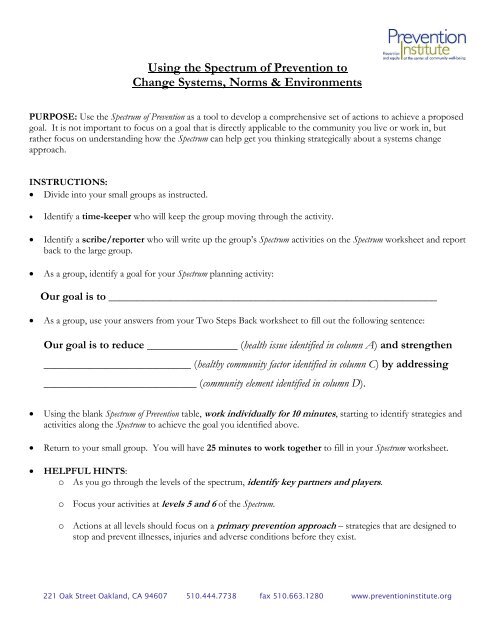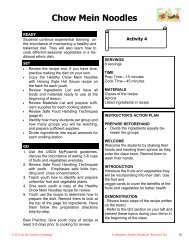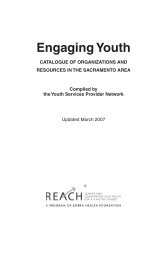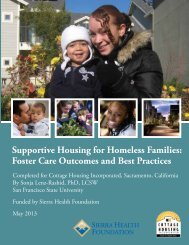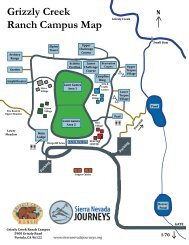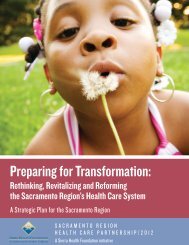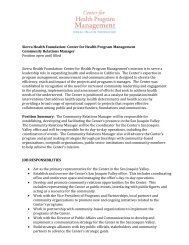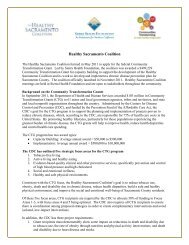Spectrum of Prevention (PDF) - Sierra Health Foundation
Spectrum of Prevention (PDF) - Sierra Health Foundation
Spectrum of Prevention (PDF) - Sierra Health Foundation
Create successful ePaper yourself
Turn your PDF publications into a flip-book with our unique Google optimized e-Paper software.
Using the <strong>Spectrum</strong> <strong>of</strong> <strong>Prevention</strong> to<br />
Change Systems, Norms & Environments<br />
PURPOSE: Use the <strong>Spectrum</strong> <strong>of</strong> <strong>Prevention</strong> as a tool to develop a comprehensive set <strong>of</strong> actions to achieve a proposed<br />
goal. It is not important to focus on a goal that is directly applicable to the community you live or work in, but<br />
rather focus on understanding how the <strong>Spectrum</strong> can help get you thinking strategically about a systems change<br />
approach.<br />
INSTRUCTIONS:<br />
Divide into your small groups as instructed.<br />
<br />
<br />
<br />
Identify a time-keeper who will keep the group moving through the activity.<br />
Identify a scribe/reporter who will write up the group’s <strong>Spectrum</strong> activities on the <strong>Spectrum</strong> worksheet and report<br />
back to the large group.<br />
As a group, identify a goal for your <strong>Spectrum</strong> planning activity:<br />
Our goal is to __________________________________________________________<br />
<br />
As a group, use your answers from your Two Steps Back worksheet to fill out the following sentence:<br />
Our goal is to reduce ________________ (health issue identified in column A) and strengthen<br />
__________________________ (healthy community factor identified in column C) by addressing<br />
___________________________ (community element identified in column D).<br />
<br />
<br />
<br />
Using the blank <strong>Spectrum</strong> <strong>of</strong> <strong>Prevention</strong> table, work individually for 10 minutes, starting to identify strategies and<br />
activities along the <strong>Spectrum</strong> to achieve the goal you identified above.<br />
Return to your small group. You will have 25 minutes to work together to fill in your <strong>Spectrum</strong> worksheet.<br />
HELPFUL HINTS:<br />
o As you go through the levels <strong>of</strong> the spectrum, identify key partners and players.<br />
o Focus your activities at levels 5 and 6 <strong>of</strong> the <strong>Spectrum</strong>.<br />
o Actions at all levels should focus on a primary prevention approach – strategies that are designed to<br />
stop and prevent illnesses, injuries and adverse conditions before they exist.<br />
221 Oak Street Oakland, CA 94607 510.444.7738 fax 510.663.1280 www.preventioninstitute.org
Using the <strong>Spectrum</strong> <strong>of</strong> <strong>Prevention</strong> to Change Systems, Norms & Environments<br />
Step 3: At each level <strong>of</strong> the <strong>Spectrum</strong> <strong>of</strong> <strong>Prevention</strong>, list activities that will address your identified community element. Develop activities that build on each other to create<br />
synergy. Be sure that your activities are primary prevention focused - designed to prevent illness and injury before they occur.<br />
Example goal: Reduce indoor smoking and exposure to second-hand-smoke.<br />
<strong>Spectrum</strong> Level<br />
Activities / Strategies<br />
6. Influencing Policy and Legislation<br />
Developing strategies to change laws and policies to influence outcomes in<br />
health and safety.<br />
(Example: City Council passes a smoke-free multi-unit housing ordinance.)<br />
5. Changing Organizational Practices<br />
Adopting regulations and procedures to improve health and safety and create<br />
new standards for organizations.<br />
(Example: Building Management Company ensures employees are trained on the benefits <strong>of</strong> smoke-free<br />
multi-unit housing.)<br />
4. Fostering Coalitions and Networks<br />
Bringing together groups and individuals for broader goals and greater impact<br />
(Example: A coalition <strong>of</strong> health advocates, clinicians, and public health pr<strong>of</strong>essionals come together to<br />
work on tobacco use prevention policies including smoke-free multi-unit housing.)<br />
3. Educating Providers<br />
Informing providers who will transmit skills and knowledge to others or to<br />
become champions or advocates for your goal.<br />
(Example: Sharing with building managers the benefits <strong>of</strong> smoke-free multi-unit housing and how<br />
these policies can increase comfort <strong>of</strong> residents and improve health.)<br />
2. Promoting Community Education<br />
Reaching groups <strong>of</strong> people with information and resources to promote healthy<br />
eating, activity and safety or to prevent unhealthy practices.<br />
(Example: Letter to the Editor or article in local newspaper discussing smoke-free mult-unit housing<br />
policies and tobacco use prevention.)<br />
1. Strengthening Individual Knowledge & Skills<br />
Enhancing an individual’s capacity to eat healthy, get active or to avoid<br />
unhealthy behaviors / environments.<br />
(Example: Quit-line to help tobacco users learn cessation behaviors.)<br />
221 Oak Street Oakland, CA 94607 510.444.7738 fax 510.663.1280 www.preventioninstitute.org


